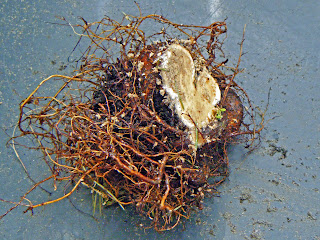Thirteen months ago, I applied what I've called the "flat-cut technique" to another
Ficus salicaria that badly needed a better nebari. (I think a better name for the procedure would be "flat-bottom-cut:" it gives a more adequate idea of what's involved.) You can review what was done
here.
Last Sunday afternoon I repotted the tree, and got a look at the re-grown root system. And to say I was pleased is an understatement! I cut off almost all the tree's roots last July -- here's what I found!
:-)
 |
| Not only is there an abundance of new roots, but the trunk has a decent basal plate. |
Here's a look at the underside. No roots had grown from the cut surface; they're all around the perimeter, which is exactly where I want them. More importantly, there was no sign that any fungus, mold or beasties had attacked the cut surface. Apparently the cut paste did its job well. (A little of it was still in place.)
 |
| View from below. Healthy callus (blue arrows) will cover the cut eventually, or so I hope. |
When I repotted the tree, I was able to restore the intended planting angle, which is a very gentle slant to the right -- just enough to notice.
 |
| Blue-black spots on the leaves were left by birds that had over-indulged on ripe mulberries! |
As far as I'm concerned, the flat-bottom cut technique has been validated, at least for
Ficus salicaria. I have heard success stories from others who have used it on
F. microcarpa, and I intend to use it on that species myself if the need arises.I also intend to try it in the future on other
Ficus species, such as
F. burtt-davyi. (I suspect
F. benjamina would be a good candidate for it.) It may well work for other fast-growing species, such as
Schefflera arboricola.
I have a soft spot for woody plants that "deserve a chance to be bonsai." That's usually the reason why I buy potential bonsai that I don't plan to keep in my own permanent collection: I get them started as bonsai-in-the-making (experiencing some of the joy of creation as I do,) and then find buyers for them. This is such a tree. By mid-September it should be thoroughly re-established, and I'll offer it for sale at the Fort Wayne club's Fall Show.
Unless, of course, someone comes along before that and makes me an offer I can't refuse! <wink>
:-) :-) :-)











